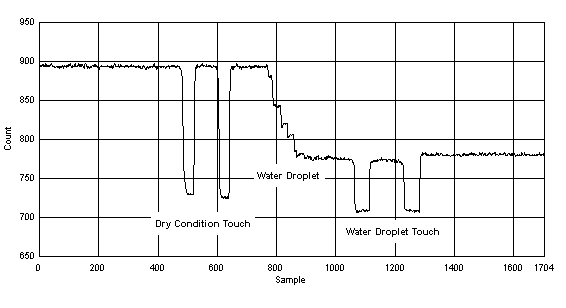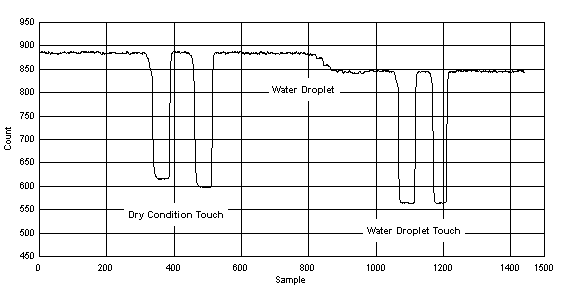TIDUE90 July 2018
- Description
- Resources
- Features
- Applications
- Design Images
- 1System Description
- 2System Overview
- 3Hardware, Software, Test Requirements, and Test Results
- 4Design Files
- 5Software Files
- 6Related Documentation
- 7About the Author
2.4.1 Shield Sensor Electrodes
Section 2.2.2 describes how liquid affects the capacitive touch sensing measurement for both self capacitance and mutual capacitance. One of the effects is due to the conductive nature of the liquid, so the liquid couples the sensor electrodes to surrounding ground or other components, which could cause false triggers. One way to reduce coupling to ground by the liquid is to minimize the ground path around the sensor.
Figure 6 shows a sensor layout that has a hatched filling connected to ground around the sensor electrode. When a liquid droplet covers the sensor area, the liquid couples the sensor to the hatch ground filling.
 Figure 6. Self Capacitance Sensor With Hatched Filling Connected to Ground
Figure 6. Self Capacitance Sensor With Hatched Filling Connected to Ground Section 2.2.3.1 describes that for self capacitance topology a finger touching the sensor electrode increases the capacitance and the liquid covering the sensor electrode with surrounding ground also increases the capacitance. For CapTIvate technology, sensor capacitance increasing means the number of charge and transfer cycles to charge the internal sample capacitor decreases, so the raw count measurements decrease when sensor capacitance increases. Figure 7 shows the raw count measurement decrease significantly when liquid droplets cover the sensor. In this scenario, there is only a small raw count difference between a valid touch and the liquid droplet, which might cause false detections.
 Figure 7. Self Capacitance Sensor Liquid Droplet Measurement Count With Hatched Filling Connected to Ground
Figure 7. Self Capacitance Sensor Liquid Droplet Measurement Count With Hatched Filling Connected to Ground To reduce the coupling to ground by the liquid, you must minimize the ground path around the sensor by shielding the sensor electrode. In Figure 8, the hatched filling around the sensor is connected to another CapTIvate I/O pin that acts as a driven shield to protect the sensor electrodes. The signal to drive the sensor electrode and the hatched driven shield have the similar waveform. The waveform makes sure that the driven shield has the same voltage potential as the sensor electrode, so that there is not a large capacitance increase when liquid droplets cover the sensor and the hatched driven shield.
 Figure 8. Self Capacitance Sensor With Hatched Filling Connected to CapTIvate I/O
Figure 8. Self Capacitance Sensor With Hatched Filling Connected to CapTIvate I/O Figure 9 shows that the raw count measurement decreased only a small amount when the liquid droplets cover the sensor. There is still a large raw count difference between a valid touch and liquid droplets, which helps to avoid false triggers and to ensure accurate touch detection.
 Figure 9. Self Capacitance Sensor Liquid Droplet Raw Count With Hatched Filling Connected to CapTIvate I/O
Figure 9. Self Capacitance Sensor Liquid Droplet Raw Count With Hatched Filling Connected to CapTIvate I/O